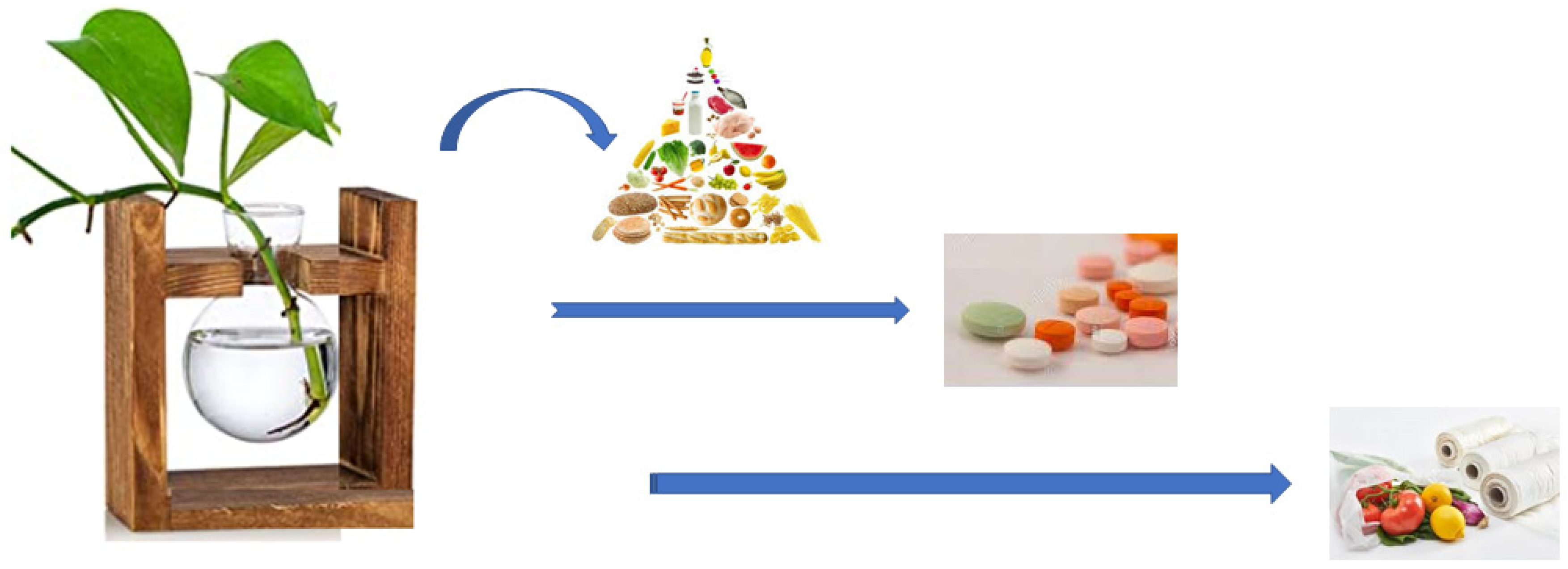Plants as Biofactories to Produce Food, Medicines, and Materials for a True Green Revolution
Funding
Conflicts of Interest
References
- Available online: https://www.who.int/news-room/feature-stories/detail/5-tips-for-a-healthy-diet-this-new-year (accessed on 26 December 2019).
- Kasprzak-Drozd, K.; Oniszczuk, T.; Soja, J.; Gancarz, M.; Wojtunik-Kulesza, K.; Markut-Miotła, E.; Oniszczuk, A. The efficacy of black chokeberry fruits against cardiovascular diseases. Int. J. Mol. Sci. 2021, 22, 6541. [Google Scholar] [CrossRef] [PubMed]
- Harvey, A.L.; Edrada-Ebel, R.; Quinn, R.J. The re-emergence of natural products for drug discovery in the genomics era. Nat. Rev. Drug Discov. 2015, 14, 111. [Google Scholar] [CrossRef] [PubMed] [Green Version]
- Park, Y.J.; Lee, K.H.; Jeon, M.S.; Lee, Y.H.; Ko, Y.J.; Pang, C.; Kim, B.; Chung, K.H.; Kim, K.H. Hepatoprotective potency of chrysophanol 8-O-glucoside from Rheum palmatum L. against hepatic fibrosis via regulation of the STAT3 signaling pathway. Int. J. Mol. Sci. 2020, 21, 9044. [Google Scholar] [CrossRef] [PubMed]
- Lu, W.; Shi, Y.; Wang, R.; Su, D.; Tang, M.; Liu, Y.; Li, Z. Antioxidant activity and healthy benefits of natural pigments in fruits: A Review. Int. J. Mol. Sci. 2021, 22, 4945. [Google Scholar] [CrossRef] [PubMed]
- Casanova, A.G.; Prieto, M.; Colino, C.I.; Gutiérrez-Millán, C.; Ruszkowska-Ciastek, B.; de Paz, E.; Martin, A.; Morales, A.I.; López-Hernández, F.J. A micellar formulation of quercetin prevents cisplatin nephrotoxicity. Int. J. Mol. Sci. 2021, 22, 729. [Google Scholar] [CrossRef] [PubMed]
- Soundararajan, P.; Park, S.G.; Won, S.Y.; Moon, M.S.; Park, H.W.; Ku, K.M.; Kim, J.S. Influence of genotype on high glucosinolate synthesis lines of Brassica rapa. Int. J. Mol. Sci. 2021, 22, 7301. [Google Scholar] [CrossRef] [PubMed]
- Masek, A.; Cichosz, S.; Piotrowska, M. Biocomposites of epoxidized natural rubber/poly (lactic acid) modified with natural fillers (Part I). Int. J. Mol. Sci. 2021, 22, 3150. [Google Scholar] [CrossRef] [PubMed]

Publisher’s Note: MDPI stays neutral with regard to jurisdictional claims in published maps and institutional affiliations. |
© 2022 by the author. Licensee MDPI, Basel, Switzerland. This article is an open access article distributed under the terms and conditions of the Creative Commons Attribution (CC BY) license (https://creativecommons.org/licenses/by/4.0/).
Share and Cite
Zarrelli, A. Plants as Biofactories to Produce Food, Medicines, and Materials for a True Green Revolution. Int. J. Mol. Sci. 2022, 23, 5827. https://doi.org/10.3390/ijms23105827
Zarrelli A. Plants as Biofactories to Produce Food, Medicines, and Materials for a True Green Revolution. International Journal of Molecular Sciences. 2022; 23(10):5827. https://doi.org/10.3390/ijms23105827
Chicago/Turabian StyleZarrelli, Armando. 2022. "Plants as Biofactories to Produce Food, Medicines, and Materials for a True Green Revolution" International Journal of Molecular Sciences 23, no. 10: 5827. https://doi.org/10.3390/ijms23105827
APA StyleZarrelli, A. (2022). Plants as Biofactories to Produce Food, Medicines, and Materials for a True Green Revolution. International Journal of Molecular Sciences, 23(10), 5827. https://doi.org/10.3390/ijms23105827




